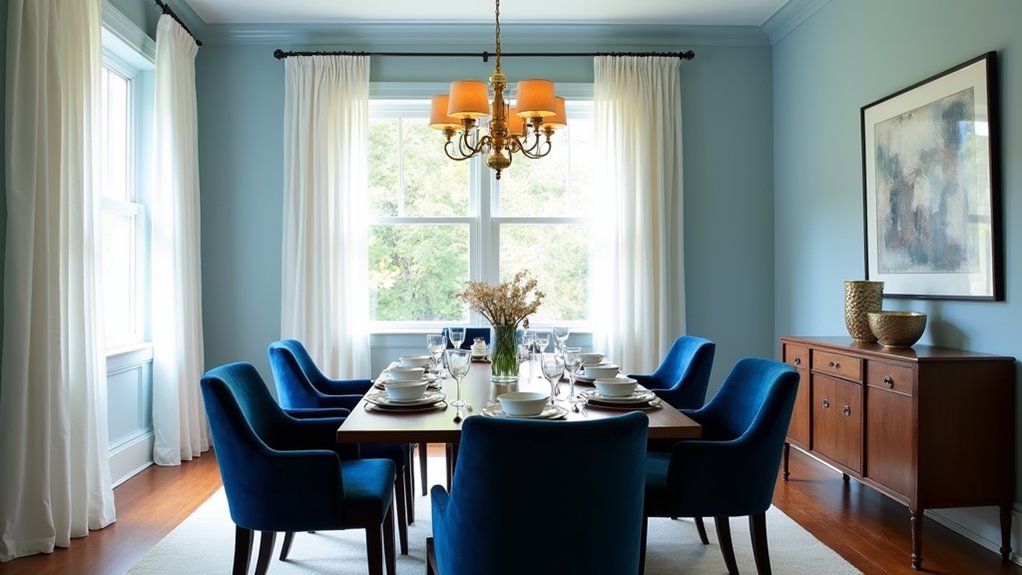Light blue dining rooms offer five distinct design approaches for sophisticated interiors. Coastal elegance combines natural wood furniture with light blue walls, incorporating rattan chairs and driftwood lighting. Modern minimalist sanctuaries emphasize spatial clarity through streamlined geometries and metallic accents. Traditional blue-and-white harmony features classic wainscoting with porcelain dinnerware. Industrial chic incorporates exposed brick with light blue accent walls and metal fixtures. Transitional styles blend warm wood tones against cool blue foundations with brass finishes for comprehensive design solutions.
Key Takeaways
- Coastal elegance combines light blue walls with natural wood furniture, rattan chairs, and driftwood lighting for relaxed sophistication.
- Modern minimalist sanctuaries use light blue palettes with streamlined furniture and metallic accents for spatial clarity and restraint.
- Classic traditional harmony pairs blue and white with wainscoting, dark wood floors, and brass chandeliers for timeless elegance.
- Contemporary industrial chic features light blue accent walls against exposed brick, concrete floors, and metal cage lighting fixtures.
- Transitional style blends light blue walls with warm wood tones and brushed gold finishes for balanced visual harmony.
Coastal Elegance With Natural Wood Accents
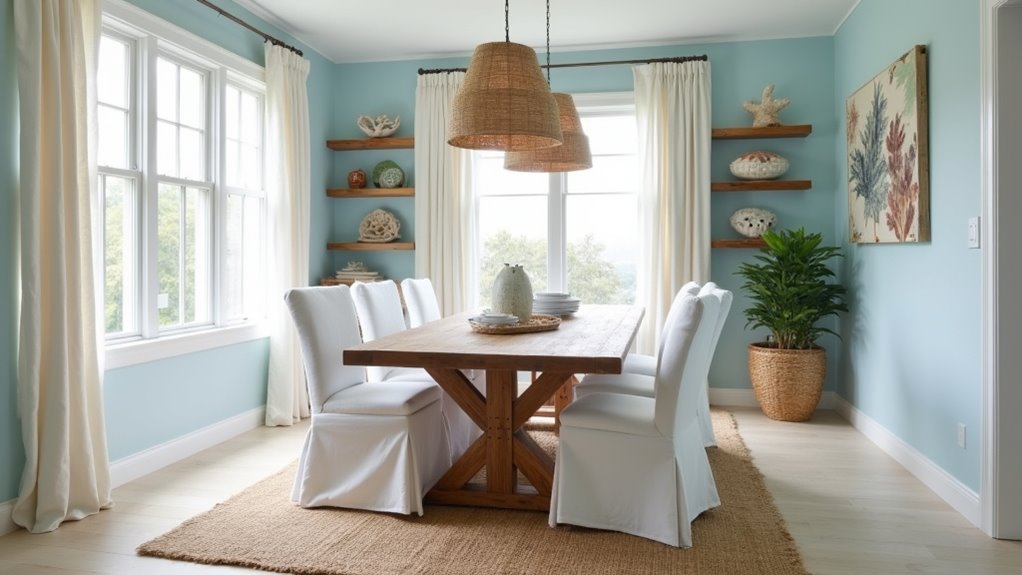
When designing a coastal-inspired dining room, the strategic pairing of natural wood accents with light blue walls establishes an immediate foundation of relaxed sophistication.
Oak and walnut furniture pieces provide warm contrast against cool blue tones, while white textiles amplify the space’s airy quality. Statement wood chandeliers anchor the design scheme, complemented by upholstered seating in coordinating blue fabrics or coastal stripes.
Seaside textures emerge through rattan dining chairs and natural fiber area rugs, creating tactile depth. Driftwood pendant lights with sun-bleached finishes in soft tans and grays add sculptural interest while maintaining the natural wood aesthetic. Nautical decor elements, including rope accents and shell-inspired art, reinforce the coastal narrative without overwhelming the sophisticated palette.
Performance fabrics ensure durability while maintaining aesthetic integrity. Strategic lighting placement using warm-toned LEDs enhances wood grain visibility and prevents blue tones from appearing cold, achieving balanced ambient illumination throughout the dining environment. Consider incorporating rectangular tables for long, narrow dining spaces to maximize the coastal aesthetic while ensuring optimal functionality. This cohesive color palette creates the perfect foundation for an open concept layout that seamlessly connects your dining area with adjacent living spaces.
Modern Minimalist Light Blue Sanctuary

Modern minimalist dining rooms achieve profound serenity through carefully curated light blue palettes that prioritize spatial clarity and visual restraint. Soft blue walls paired with neutral whites and greys create expansive atmospheres while maintaining chromatic cohesion.
Streamlined furniture featuring clean geometries—glass-top tables and slender-legged chairs—enhances spatial flow without visual obstruction. Minimalist lighting through sleek pendant fixtures and dimmable LED systems provides controlled ambiance while emphasizing the sanctuary’s tranquil qualities.
Chrome and brass accents introduce metallic sophistication without compromising aesthetic simplicity. Textural contrasts emerge through strategic material combinations: smooth ceramics against soft fabric cushions, natural wood elements providing subtle warmth.
Built-in storage solutions with flush fronts maintain uninterrupted wall planes. Single sculptural accessories and muted blue accent pieces serve as focal points while preserving the space’s contemplative essence and functional clarity. Three-light chandeliers with geometric glass panels and brass finishes perfectly complement this aesthetic by merging industrial precision with luxury materials while maintaining the space’s minimalist sophistication.
Classic Traditional Blue and White Harmony
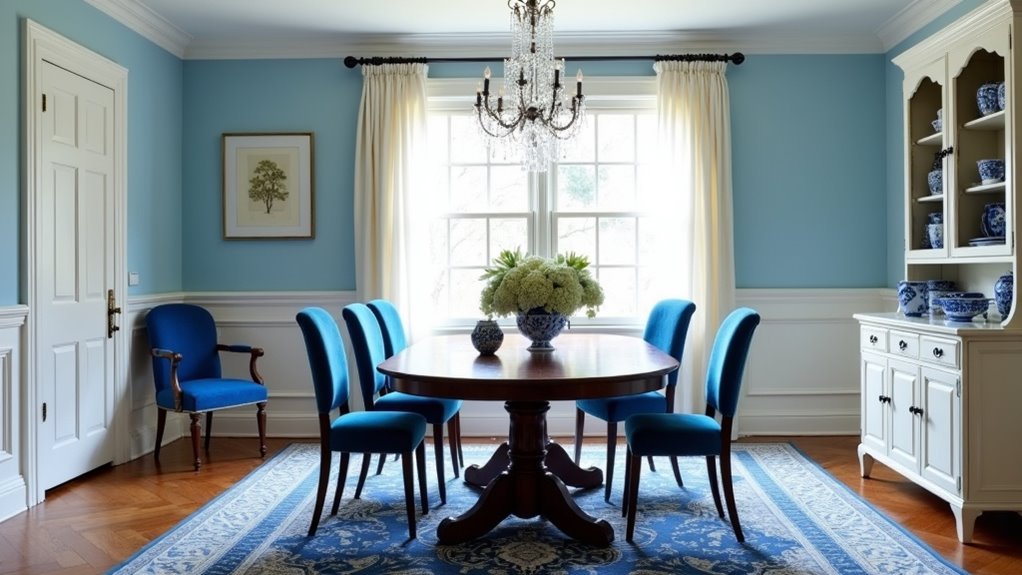
Classic traditional dining rooms embrace the enduring sophistication of blue and white palettes through established design principles that prioritize architectural harmony and timeless elegance. This color combination creates natural brightness while balancing cool undertones with crisp white elements, preventing spatial coldness.
The palette enhances both expansive colonial spaces and intimate dining areas through strategic application. White wainscoting paired with navy or light blue walls accentuates architectural details while maintaining authentic traditional character.
Dark wood flooring provides essential contrast, grounding the space with warmth against blue walls and white trim. Medium-toned wooden dining tables preserve antique aesthetics while upholstered chairs in coordinating fabrics soften hard edges.
Blue and white porcelain dinnerware and ceramic decorative accents reinforce the traditional theme. Classic brass chandeliers complement this timeless contrast, creating inviting environments perfect for formal entertaining.
Contemporary Industrial Chic With Blue Touches
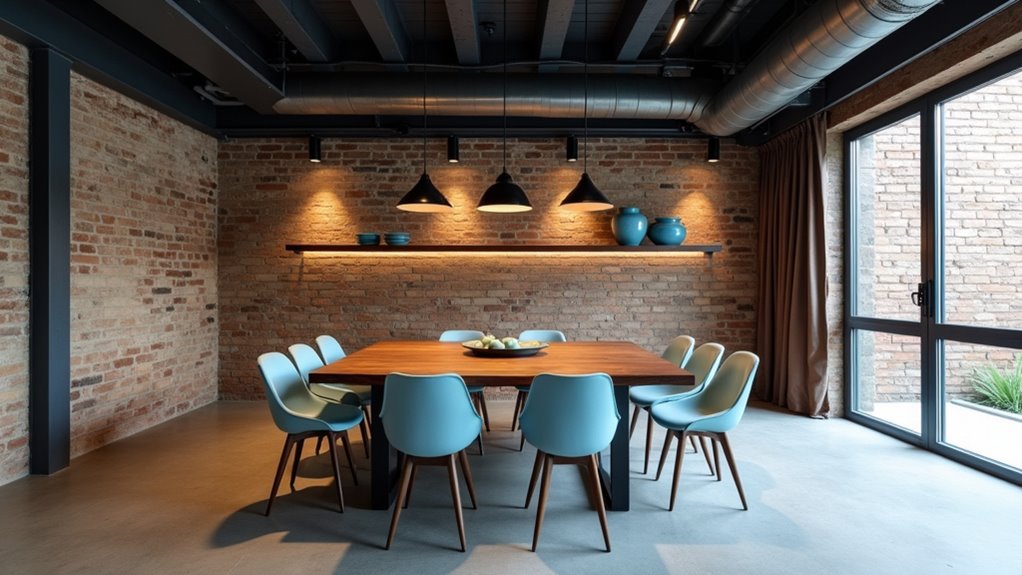
Contemporary industrial chic dining rooms achieve sophisticated urban aesthetics through strategic integration of raw architectural elements with carefully selected blue accent pieces. Exposed brick walls and concrete flooring establish the foundational texture, while industrial lighting featuring pendant fixtures with metal cage shades provides functional illumination. Metal accents through chairs, tables, and light fixtures introduce essential edge and character to the space.
Light blue accent walls create color pops without compromising the industrial atmosphere. Blue-tinted glassware and LED lighting generate unique ambiance, while blue cushions on metal seating add controlled color injection. The neutral background allows blue elements to stand distinctly against industrial materials.
Successful implementation requires balancing raw materials like metal, wood, and concrete with chic accessories. Track lighting offers adjustable functionality, while exposed utilities maintain authentic industrial authenticity throughout the dining environment.
Transitional Style Blending Warm and Cool Tones
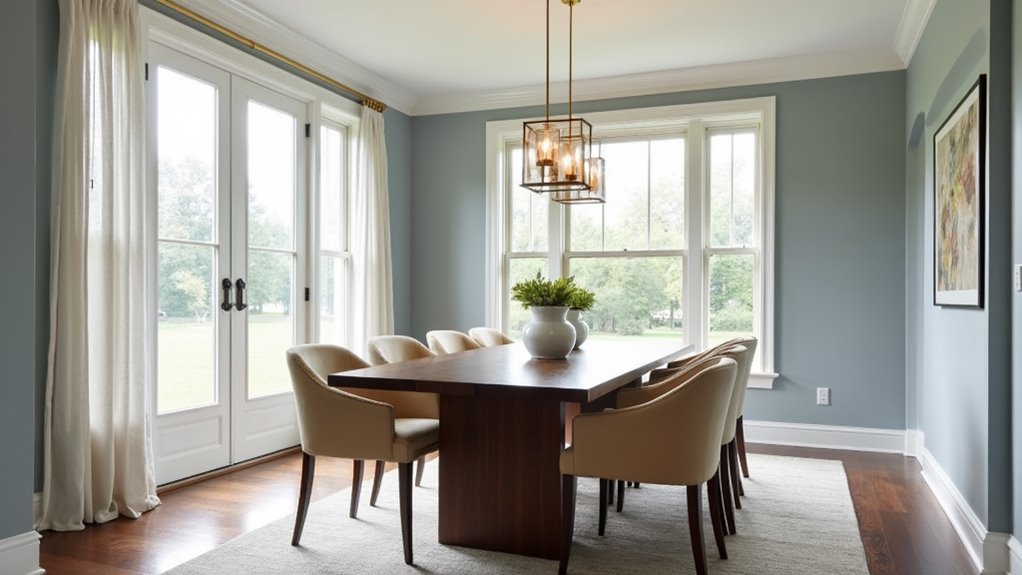
Transitional dining rooms achieve sophisticated balance through strategic integration of warm and cool color palettes, creating spaces that bridge traditional comfort with contemporary refinement.
Light blue walls establish the primary cool foundation, while warm neutrals like beige and taupe in furniture selections provide essential counterbalance. Wood tones in oak or walnut introduce organic warmth against blue upholstery, while brushed gold or brass metallic finishes add luminous warmth without overwhelming the cooler hues.
Texture contrast emerges through natural linen and wool materials in neutral shades against sleek blue surfaces.
Warm-toned lighting fixtures create inviting ambiance, complemented by layered illumination strategies.
Cohesive accessories including artwork with mixed warm-cool palettes, terracotta planters, and woven textiles reinforce the transitional aesthetic while maintaining visual harmony throughout the space. Consider incorporating mixed metal accents in your lighting selections to enhance the sophisticated interplay between warm brass or copper elements and cooler finishes.
